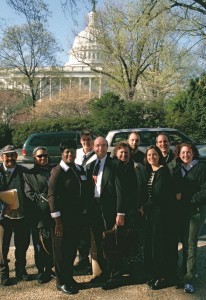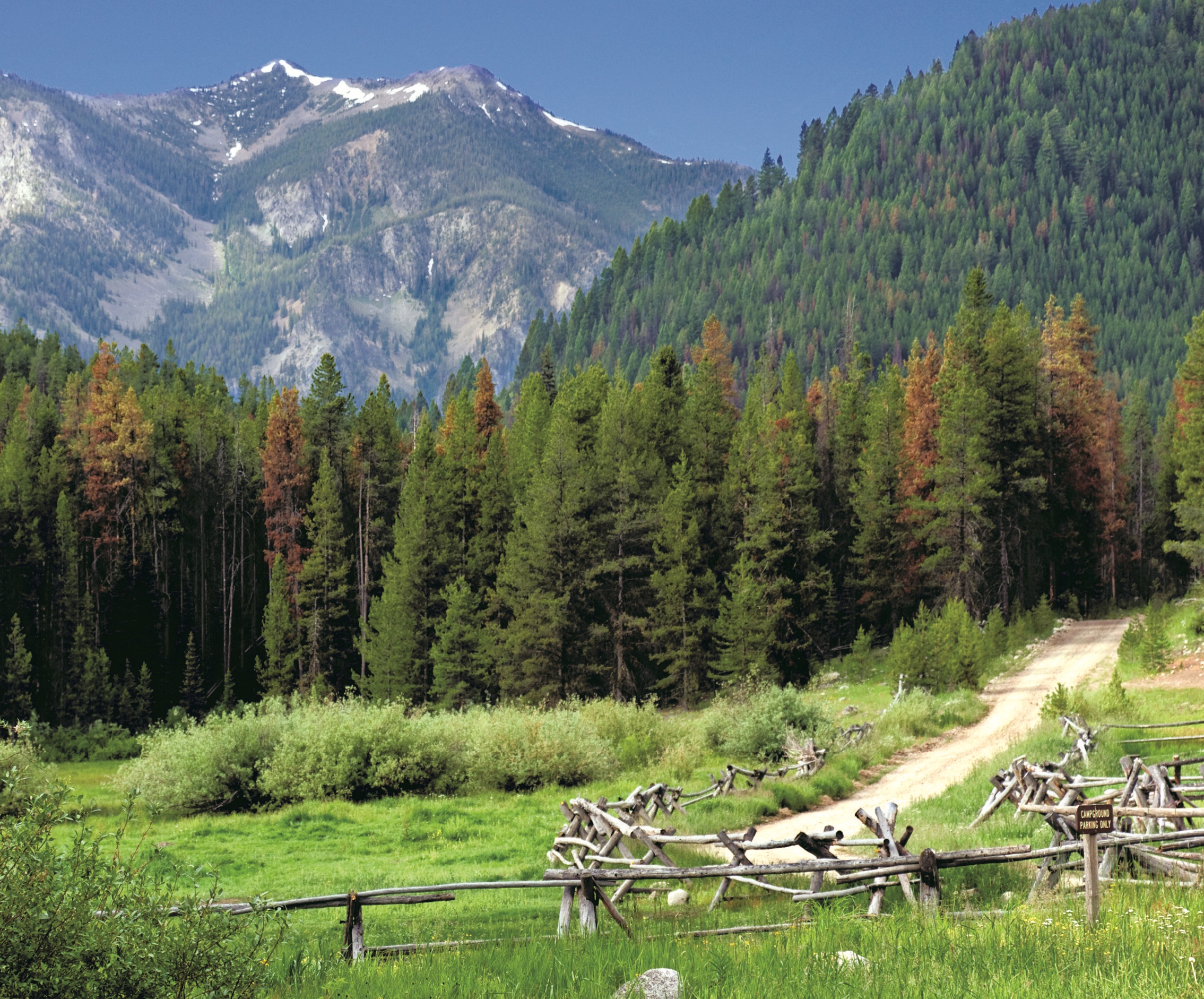Community-based conservation has affected the participants from grassroots organizers in their tiny towns to federal bureaucrats in DC. They have emerged with a new ethic that demands working as partners and adapting to change together.
Story and photos by Jane Braxton Little
At first it was little more than a vision—a belief that rural people could nurture their communities by caring for the forests in their own backyards. The believers were a rag-tag group of housewives, local officials, loggers, and landowners. They had little power beyond their certainty that together they could form partnerships to repair the broken-down systems that were degrading their public lands and devastating their small towns.
Today that vision has burgeoned into a national movement known as community-based conservation. Born out of frustration with federal land-management programs and their failure to benefit rural communities, it is recognized from the halls of the US Congress to the backwoods of Idaho. At a time when one in three rural kids lives in poverty, this grassroots movement remains far short of eliminating the cycles of boom and bust that plague resource-dependent economies. But it has nudged new policies out of federal bureaucracies and created jobs for thousands of people.
“I’ve never been more optimistic,” says Jack Shipley, co-founder of the Applegate Partnership, and an early rural coalition organizer.
What began with a handful of tentative arrangements—thinning 10 acres of national forest here, 12 there—has grown to multi-year contracts to restore tens of thousands of acres of public land. Last year the Forest Service entered into 8,931 grants and agreements with hundreds of partners on projects valued at over $1.48 billion. Community-based conservation has altered the process of managing federal lands, says Joe L. Meade, acting Associate Deputy Chief of the US Forest Service.
It has done this on the strength of four key concepts: collaboration, stewardship, reinvestment, and monitoring. Instead of duke-it-out disputes to determine who does what on the land, partnerships of environmentalists, woods workers, and agency officials are sharing the responsibility. Instead of tree-by-tree projects that look no farther than the next hillside and year, national forests are planning decade-long work that restores ecosystems across entire landscapes. Instead of dumping restoration revenue into the national treasury, it is being returned to the local area to fund additional stewardship projects. And instead of completing a project and hoping for the best, anyone with an interest is encouraged to scientifically scrutinize the results to improve the next project.
“We’ve changed the conversation at the national policy level,” says Maia Enzer, policy program director at Sustainable Northwest in Portland, Oregon.
Stalemate to Stewardship
When Enzer and a committee of community representatives first organized, the discourse was less conversational than confrontational. After decades of domination by a get-out-the-cut mentality to maximize timber harvests, Forest Service managers were trapped between industrial timber companies, which wanted to continue aggressively harvesting big trees, and environmentalists bent on halting all logging on national forests. These old enemies gathered in 1996 at the Seventh American Forest Congress in the glitz of Washington’s Sheraton ballroom alongside academics, agency officials, and small-town activists—all elbow-to-elbow under the crystal chandeliers.
For Shipley, it was the first time he had a place at the table. A lean landowner with a thinning ponytail, Shipley spent a decade battling local loggers and fighting timber sales in rural southern Oregon. When his longtime logger foe reached out to him, Shipley reached back. They formed the Applegate Partnership, and began planning federal timber sales that would protect local creeks and meadows.
Very little happened: “We were totally naïve. We weren’t even a part of the ballgame,” he says.
But like other rural residents, Shipley was dedicated to healing the land that surrounded his home. He realized that grassroots activists’ only power was to commit to working with anyone who could be part of the solution. By refusing to participate in traditional divide-and-conquer tactics, Shipley and other community representatives used their outsider status to create a third way: collaboration.
Through the Forest Congress, and with the support of Fran Korten of the Ford Foundation, they formed a group known as the Communities Committee under the initial leadership of Lynn Jungwirth from Hayfork, California, then Carol Daly of Columbia Falls, Montana. They went home to launch small projects on federal land that restored eroded streams and removed the small trees that were increasing the risk of wildfire and disease. The work was designed to improve the health of the land and provide local jobs.
Over the next few years, the Communities Committee members worked with the Forest Service and Bureau of Land Management officials, often raising their own money to fund projects demonstrating that local workers had the equipment and the skills to restore damaged land. They also encouraged new approaches for the federal agencies to develop and fund these projects, including stewardship contracting. Local agency officials were generally enthusiastic, and joined the community activists in calling for further exploration of stewardship contracting. In 1999, Congress authorized 28 pilot projects that included provisions for multiple stakeholders to assess the long-term potential of this tool.
Today stewardship contracting has strong support from Forest Service Chief Tom Tidwell, and is an active part of forest management programs throughout the West. In Oregon and Washington, one of the more aggressive regional programs treated nearly
28,000 acres last year, doubling the previous annual acreage. In addition to promoting local collaboration and healthier forests, these 10-year contracts yielded 160 million board-feet of lumber, nearly one-third of the region’s total board-footage for sawlogs, chips, and biomass.
The stewardship program is also a moneymaker. In 2010, the revenue from sawlogs, biomass, and wood chips harvested on stewardship projects in Region Six yielded $11.1 million. Around $6 million was paid to contractors for the work they performed. The remaining $5.1 million will be reinvested in future stewardship contracts, says Tracy Beck, acting Region 6 director of natural resources.
Boots-on-the-Ground Coalitions
Stewardship contracting did not become an accepted practice on federal lands simply on the merits of benefitting the land and local economies alone. The Communities Committee quickly realized the need for new federal policies that would direct agency officials to design and fund these projects, and offer incentives for innovations. Enzer had been a policy director with American Forests based in Washington, DC, but in 2000 she moved west to focus on the collaborative initiatives underway at Sustainable Northwest.
A vivacious woman with a mop of curly brown hair, Enzer understood the role western communities could play in shaping land management policies. She continued “Week in Washington,” a program that brings leaders of small-town coalitions to DC to meet with their elected representatives. Idaho loggers, New Mexico ranchers, and California mushroom pickers have all trekked to the nation’s capital to pitch their solutions for the on-the-ground dilemmas they face. Calling themselves the Rural Voices for Conservation Coalition (RVCC), they have formed a cadre of citizen lobbyists in Carhartts and Bean boots.
The RVCC offers support to leaders developing projects in isolated communities, and provides elected officials with a community perspective on conservation, something that had not been done before. “People feel empowered by being part of a coalition,” says Enzer, who coordinates the group. “This is their agenda. They are participating in their own democracy—what America is all about.”
Their close ties to the land and consistent call for collaboration give these grassroots leaders an authenticity that has earned respect among policymakers. Their commitment to restoring natural resources has also attracted environmentalists. Todd Schulke, a founding member and forest-policy analyst with the Center for Biological Diversity, began watching from afar as Enzer mobilized rural communities to drum up support for policy changes. Although Schulke and his environmental organization emerged from the timber wars as victors, he realized the work of restoring forest landscapes was just beginning: “We won the war, and the wounded were out in the woods. These people knew things I don’t know—things I need to know.”
Once he was convinced it didn’t represent the timber industry, Schulke began working with the RVCC. Today he calls it “the most organized savvy policy group in the country.”
Several national environmental organizations have made significant changes in their approach to restoration that reflect the influence of communities. The Wilderness Society has added a green-jobs program to its national agency, and works closely with local groups to make their forests more resilient to wildfire. The Nature Conservancy has become a leading advocate for collaboration in resolving land-use dilemmas. Enzer says the participation of national environmentalists has helped community groups understand traditional policy-making, an important step to changing it.

One of collaboration’s most significant achievements is the preservation of 320,000 acres of Montana’s working landscape through a 2009 act of Congress. Northwest Connections, a tiny nonprofit organization in Swan Valley and an RVCC member, worked with Trust for Public Lands, The Nature Conservancy, and Plum Creek Timber Company to protect these industrial timberlands from conversion to housing and commercial development (see “Ensuring a Timberland Legacy,” American Forests, Winter 2009). Along with protecting the land, the agreement includes a commitment to deliver 92 million board-feet of logs to local sawmills.
Enzer credits Northwest Connections for reaching out to environmental and timber groups to achieve this landmark legislation: “We are the grassroots of the conservation movement,” she says. “We are the people making it happen, and we are doing it by working together.”
Community coalitions are active throughout the country. The issues east of the Mississippi are somewhat different, but the commitment to collaboration is identical, says Gerry Gray, senior vice president of programs at American Forests. The Central Appalachian Network has brought together seven nonprofit groups in five states to coordinate a forest-products network that supplies certified wood and wood products to schools, hospitals, and other civic centers. It is part of a larger effort to create economic, environmentally sustainable opportunities using local workers and natural resources.
In the Southeast, the National Wildlife Federation is working with the Forest Service and the Federation of Southern Cooperatives to develop programs that ensure the future of minority-owned forests. Among them are longleaf pine restoration, and a plan to link individual owners for group certification through the Forest Stewardship Council.
In New Hampshire, representatives of 40 different communities, organizations, and public agencies have assembled a roadmap to guide them through the issues of using wood biomass for heating and power generation. It came as a response to construction of several biomass facilities around the state, and interest in using local resources to plan for the energy future of communities throughout New Hampshire.
American Forests recently brought together around 30 local groups to form the Coalition for Eastern Forests and Communities. Oriented more toward private forests than its western counterpart, the coalition is working with RVCC to build a national movement for community-based conservation, says Gray.

Policy and Partnerships
The Eastern Coalition is forming at a time when the grassroots movement boasts an impressive legacy of policy accomplishments. Since the 1999 stewardship legislation, it has helped pass New Mexico’s Community Forest Restoration Act of 2000; the Secure Rural Schools and Community Self-Determination Act of 2000, designed to compensate counties with federal land for lost property taxes, reauthorized through 2011; portions of the 2003 Healthy Forests Restoration Act; and parts of the 2008 Farm Bill that provide incentives for collaboration and habitat restoration. The most recent policy achievement is the 2009 Collaborative Forest Landscape Restoration Act, which encourages large-scale, long-term, and collaborative forest restoration projects on federal lands.
The Forest Service relies on community collaboration to accomplish its mission, says Meade, the deputy assistant chief. The groups have helped reduce the incidence of land-management disputes and the costs of resolving them. Shifting problem solving toward a more open and democratic process has also brought “new excitement, creativity, and hope into the realm of natural resource management,” Meade says.
 The movement has had its share of disappointments. Jefferson State Forest Products was a forest community icon—a bootstrap business hailed for manufacturing wooden fixtures in rural Hayfork, California, a town of 2,600 residents. Launched by Jim Jungwirth and Greg Wilson, it was a step toward restoring jobs to the community after Sierra Pacific Industries closed its sawmill in 1997. In December, Upstream 21, the owner since 2007, announced it would move the operation to Grants Pass, Oregon, despite a gentlemen’s agreement to stay in Hayfork.
The movement has had its share of disappointments. Jefferson State Forest Products was a forest community icon—a bootstrap business hailed for manufacturing wooden fixtures in rural Hayfork, California, a town of 2,600 residents. Launched by Jim Jungwirth and Greg Wilson, it was a step toward restoring jobs to the community after Sierra Pacific Industries closed its sawmill in 1997. In December, Upstream 21, the owner since 2007, announced it would move the operation to Grants Pass, Oregon, despite a gentlemen’s agreement to stay in Hayfork.

Combined with its early successes, the setback in Hayfork offers lessons that are helping communities around the West, says Enzer. Among those benefitting is the timber town of Lakeview, Oregon. In 1990 Lakeview had four operating sawmills. By 1998 the only one left was Fremont, owned by Collins Pine Co. Concerned that their community would lose that one, too, county commissioners began looking for help. They found Martin Goebel, founder and president of Sustainable Northwest. Goebel began working with county and Collins Pine officials on a plan to harvest trees from 500,000 acres of the Fremont Winema National Forest. His primary tool was collaboration.
To make a partnership work, everyone has to give something up, says Wade Mosby, Collins’ senior vice president. Collins gave up logging old-growth trees. “A lot of timber companies would fight over that. We said we’ve got to be realistic,” Mosby says. So Collins retooled its Fremont Sawmill for small-diameter logs, hoping that environmentalists would recognize the benefits of removing the small trees choking the national forest.
Mosby says the turning point came when Andy Kerr, “dean of everything environmental in all of Oregon,” wrote an opinion piece for the local newspaper giving the project his approval. In November, Lakeview officials announced authorization of a biomass plant to be built next to the Collins Pine sawmill and fueled by logging and mill residues. Incoming up with a combination of projects that create local jobs and improve forest health, the Lakeview leaders have taken a traditional forest economy and used it to initiate renewable energy.
The Changing Challenges
Energy will continue to be a focus as rural areas work to achieve greater self-sufficiency. In addition to biomass and wood-pellet plants, many communities are in the process of exploring or installing solar, geothermal, and wind-energy facilities. Moving from ecosystem restoration to energy independence shows how community-based conservation is expanding its scope from small and relatively simple forest-restoration projects to those that encompass the larger landscape. Defining natural resource work in this broader context is convincing youth to return to or stay in their rural hometowns. They are drawn by fisheries and watershed restoration, as well as the opportunity to revive family ranches and farms.
For these programs to succeed, the future must also include changes in the way federal agencies fund the work. Instead of separate accounts restricted to hazardous fuels or flood control, land managers need a budgeting process that allows them to reinvest in restoration across entire landscapes. Enzer is encouraged that President Obama included integrated resource restoration as a line item in his current budget.
Liberating resource-dependent economies from boom-bust cycles remains mostly elusive, but Enzer is unequivocal about the goal: “The pendulum stops here.” She points to the number of people engaged in the movement—thousands beyond the handful of pioneers who launched the community-based conservation movement 15 years ago. She ticks off a long list of landscapes across the country where the benefits of their hard-fought efforts are obvious.
Community-based conservation has affected participants from grassroots organizers in their tiny isolated towns to federal bureaucrats in downtown DC cubicles. They have emerged with a new ethic that demands working as partners and adapting to change together.
“The world has changed, but the ecological need for work has not,” Enzer says. “If we continue to work together, there’s nothing we can’t take on.”
Jane Braxton Little writes from Plumas County, CA.



